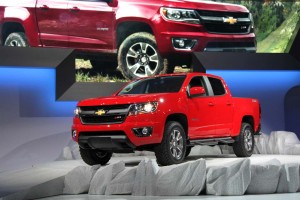
Chevrolet will offer both a fuel-efficient I-4 engine and a more powerful V-6, with a diesel coming a year later.
With sales exceeding initially cautious expectations, General Motors plans to sharply boost production of its new Chevrolet Colorado and GMC Canyon pickups.
GM will add a third shift at the plant in Wentzville, Missouri that produces the two midsize trucks. That move will create another 750 jobs at the factory, which also produces the Chevy Express and GMC Savanna full-size vans. GM had previously invested $513 million at the Wentzville plant to handle the addition of the new pickups, creating 1,315 jobs in the process.
The maker has taken an unusually large number of early orders for the Colorado and Canyon models, it says, about 30,000 so far. There had been plenty of concern that GM might miss the mark with the two trucks considering the decline in the midsize segment over the last two decades.
In the 1970s, automakers sold more midsize pickups than full-size models, in part due to the availability of low-cost offerings that appealed to the Baby Boomers just then getting their drivers’ licenses. But by the ‘90s, demand had largely shifted to full-size models that grew to become one of the single-largest segments in the U.S. automotive market.
(GM pushing for leadership in the once-huge midsize pickup market. Click Here for more.)
After tumbling sharply during the Great Recession, full-size models have been regaining momentum as the economic recovery leads many contractors and businesses to trade in their old trucks. Large models, such as the Chevrolet Silverado, the GMC Sierra, the Ford F-Series and the Ram 1500, outsold midsize pickups by almost a 10-to-1 margin last year.
Projecting the continued decline of the midsize segment, Ford abandoned its aging Ranger model several years ago, even though it had developed an all-new version for overseas market. Chrysler also walked away from the segment, though it is now developing a new offering. Hyundai and Kia, which have long considered their midsize options, have chosen to put off their own entries – at least for now.
That largely has left the market to the Japanese, notably Toyota with its Tacoma, the midsize pickup sales leader. Nissan has been holding steady in second with its Frontier line. Honda pulled the plug on its “tweener,” the Ridgeline, but recently announced plans to develop an all-new version of the only pickup using a crossover-style platform.
(Nissan drops some hints about all-new full-size Titan pickup. Click Here to check it out.)
Many analysts questioned GM’s decision to return to the midsize truck segment after a brief hiatus. But initial results have exceeded even the maker’s own, upbeat forecast.
GM has scored well with truck buyers on several fronts. The two new offerings deliver segment-leading fuel economy numbers. And the two brands will become the only ones to offer a diesel powertrain option in the midsize market come 2016.
Price also appears to be working in GM’s favor, the base version of the Colorado extended-cab model with a standard 200-horsepower, 2.5L four-cylinder engine starting at $20,995 including destination charge. (A well-equipped Crew Cab Long Box Z71 edition with a 3.6-liter V-6 will push that up to $36,000 or more.)
Whether the initial burst of demand continues to hold remains to be seen, but the Wentzville plant announcement suggests GM is confident that it has scored a hit with the new Chevrolet Colorado and GMC Canyon models.
That raises the question whether other players might now reconsider their options, most notably Ford which is betting big on the all-new, aluminum-bodied version of its full-size F-150 pickup coming late this year. For now, at least, Ford says it has no intention of reentering the midsize segment. But that could change if GM continues to show that there’s new life in the smaller pickup market.
(Toyota offers teaser of new C-HR Crossover concept. Click Here to see if this will be a new Scion model, or even a RAV4 replacement.)

Trends are to be follows. What is the buyers expectation in this market? First fuel economy without leaving the anmenities of the Pick up truck. Second, Pick up size that fullfill the need of this generation buyers.